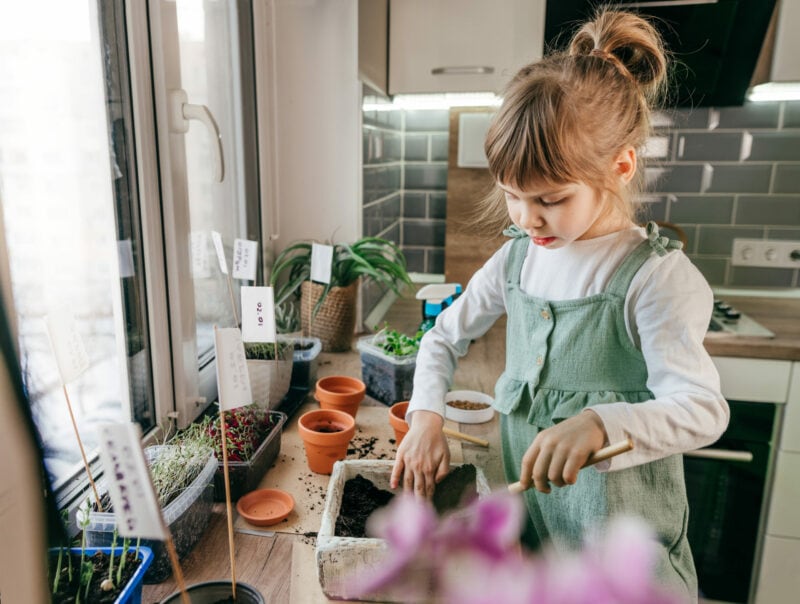Sowing love

The imminent arrival of spring – and hopefully better weather – provides the perfect opportunity to get into the garden with children. Words Gretchen Carroll
Gardening with children can be rewarding for the whole family, whether it’s your kids, your grandkids or extended whānau, and you all get to enjoy the fruit of your labour. Being outside in nature has many positives for kids – it promotes healthy growth of their mind, body and spirit, stimulates all their senses, and instils a love of the outdoors. They learn where fresh produce comes from, and enjoy eating it straight from the garden, which (hopefully) encourages them to enjoy fruit and veges more. Most children love
getting their hands dirty, and time spent outside means less time in front of screens!
Our garden has always been our 8-year-old son’s ‘happy place’, whether it’s getting muddy, helping with the gardening or creating his own fun, so here are some tips from our experience.
Downsizing matters
Tamariki usually love being outside, so you probably won’t have any trouble getting them out the back door. To introduce them to the joys of gardening, first get hold of the right-sized gear – check out op shops or garden centres for child-sized gardening gloves and a spade, although small adult trowels work okay for little hands. Perhaps a small watering can and a rake for the autumn leaves later on. If they are using adult-sized tools, think about what is safe for their age.
Now you have the gear, think about what age and stage the particular child is at. Older preschoolers and school-aged kids are capable of, and will enjoy helping with, planting vegetables and flowers, whereas the really young ones might be tempted to eat the potting mix. Perhaps a better job for littlies is watering the plants with a small watering can; save the planting for the older ones. Most ages can help with weeding, although the younger ones will need guidance on what is a weed.
Kid-friendly picks
No matter the season, either quick-growing plants or ones that have interesting results are the most rewarding for children. Let them help when planting and talk through what you’re doing and why.
For spring, consider sowing pumpkin seeds – family members could even have a competition to see whose pumpkin ends up the biggest, and heirloom varieties of corn are fun for children to follow the results. All varieties of tomato seedlings are good, particularly cherry tomatoes, which are the perfect size to pick and eat. For a novel challenge one spring, my son and I planted yacón, a South American root vegetable, which he loves to eat raw like a fruit. The plants are slowly, but surely, taking over one patch of the garden and he’s delighted they’re now almost taller than him. Herbs are also a nice one to plant together – lovely for them to smell, nibble and learn different flavours.
Once summer arrives, lettuce seedlings are a good place to start, as they’re easy to grow and it’s salad season. Sunflowers are loved by kids; these can be planted as seeds and make sure they have a sunny spot. You can either sow fullsized sunflowers (see who is taller by the end of summer, the flower or the child?), while dwarf sunflowers are cute.
Heading into autumn, peas and beans are easy to pick and eat, also sweet pea flowers make a nice choice because of their colours. Try planting broccoli seedlings – not often a dinner favourite, but by going through the process of planting, picking and cooking, you might even have some luck with the eating.
Lastly, winter is an ideal time to start sprouting potatoes. This is a fun process to watch, and once you get to summer and autumn, digging out potatoes is like a treasure hunt. Also get your strawberry seedlings in, often a favourite fruit with all ages.
At any time of the year, tamariki can be involved in setting up some microgreens to grow. Microgreen seeds and small plastic ‘greenhouse’ containers are available at garden centres or simply grow them on the windowsill in small pots or recycled coffee cups. It’s an easy process and it won’t take long to see the results, which can then be trimmed with scissors before washing and eating.
Going on a bug hunt
The arrival of spring is an ideal time to look for nests (from a distance) and encourage bird watching. Go on a bug hunt and see what they can find. You can make your garden more insectand lizard-friendly by leaving piles of wood, stones or bricks and leaf litter around. These make good hiding spots for creepy crawlies, and kids will have a great time searching to find them (plus slug hunting will protect those plants you have worked hard on planting together).
Teach children about the benefits of bees and how to be safe around them. At any time of year, worm farms are an excellent way to make the most of your scraps and children like seeing the wriggling worms. These are available from many outlets and easy to set up.
Tamariki love to be involved in looking after a worm farm, which has the added benefits of providing nutrients for the garden.
Finally, I asked my son what adults need to remember about gardening with kids. “Give them their own area to do what they want with. Include them in exciting garden work, and don’t be too fussy or get upset if they do something like step on a seedling.”
Some great advice from the 8-year-old there and apparently his parents are doing pretty well on these points.
